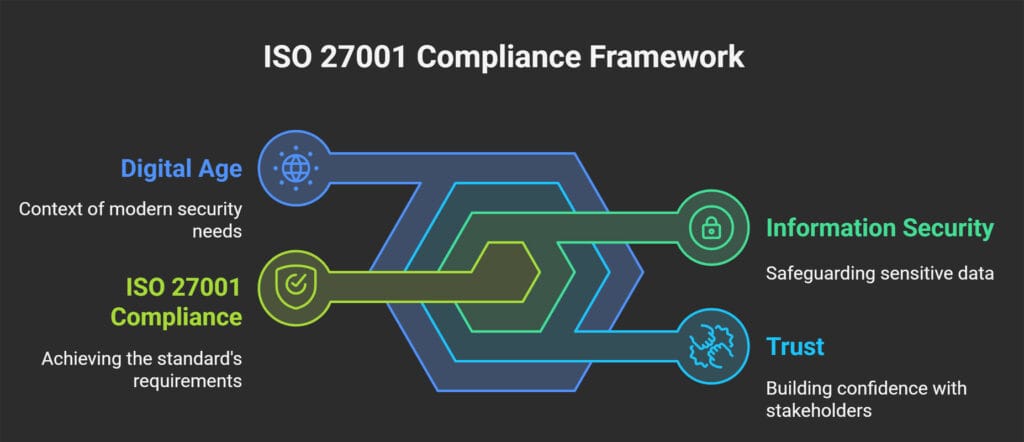Home » Step-by-Step Guide to Achieving ISO 27001 Compliance
Step-by-Step Guide to Achieving ISO 27001 Compliance
In today’s digital age, information security has become a top priority for organisations worldwide. Achieving ISO 27001 compliance is a critical step in demonstrating your commitment to safeguarding sensitive data and maintaining trust with clients, partners, and stakeholders. This step-by-step guide will walk you through the process of achieving ISO 27001 compliance, ensuring your organisation is equipped to meet the standard’s rigorous requirements.
What is ISO 27001?
ISO 27001 is an internationally recognised standard for Information Security Management Systems (ISMS). It provides a framework for managing sensitive company information, ensuring its confidentiality, integrity, and availability. Compliance with ISO 27001 not only enhances your organisation’s security posture but also builds credibility and trust.

The Path to Certification: A Phased Approach
Achieving ISO 27001 certification is a structured journey, not a destination. It involves a continuous cycle of planning, implementation, assessment, and improvement.
Step 1: Understand the ISO 27001 Standard
Before embarking on the compliance journey, familiarise yourself with the ISO 27001 standard. Key components include:
- Annex A Controls: A comprehensive list of 93 security controls (updated in ISO 27001:2022) that address various aspects of information security.
- ISMS Framework: A systematic approach to managing sensitive data, including processes, policies, and technologies.
- Risk-Based Approach: The standard emphasises identifying, assessing, and mitigating risks.
Step 2: Secure Leadership Support
ISO 27001 compliance requires organisational commitment, starting from the top. Ensure that your leadership team understands the benefits of compliance and is willing to allocate the necessary resources, including time, budget, and personnel.
Step 3: Define the Scope of Your ISMS
Clearly define the scope of your ISMS to determine which parts of your organisation, processes, and systems will be covered. Consider:
- Business objectives
- Organisational structure
- Information assets
- Regulatory requirements
Step 4: Conduct a Gap Analysis
Perform a detailed gap analysis to assess your current information security practices against ISO 27001 requirements. This will help you identify:
- Existing strengths
- Areas for improvement
- Missing controls or processes
Step 5: Develop a Risk Assessment Methodology
ISO 27001 emphasises a risk-based approach. Develop a methodology to identify, assess, and treat risks associated with your information assets. Key steps include:
- Identifying information assets and their vulnerabilities.
- Assessing the likelihood and impact of potential threats.
- Prioritising risks based on their severity.
- Implementing appropriate controls to mitigate risks.
Step 6: Establish Policies and Procedures
Develop and document the necessary policies, procedures, and guidelines to support your ISMS. These should include:
- Information Security Policy
- Risk Management Policy
- Access Control Policy
- Incident Management Procedures
- Business Continuity Plans
Ensure that these documents are aligned with ISO 27001 requirements and are accessible to relevant stakeholders.
Step 7: Implement the Required Controls
Based on your risk assessment, implement the necessary controls outlined in Annex A of ISO 27001. Examples include:
- Encryption and access controls
- Physical security measures
- Employee training and awareness programs
- Regular security audits and vulnerability assessments
Step 8: Conduct Internal Audits
Regular internal audits are essential to evaluate the effectiveness of your ISMS and identify areas for improvement. Assign qualified personnel or engage external auditors to perform these audits.
Step 9: Perform a Management Review
Conduct a management review to assess the performance of your ISMS. This involves evaluating:
- Audit findings
- Risk treatment plans
- Security incidents and responses
- Opportunities for continual improvement
Step 10: Prepare for the Certification Audit
Once your ISMS is fully implemented and operational, prepare for the certification audit. This involves:
- Stage 1 Audit: The auditor reviews your documentation to ensure compliance with ISO 27001 requirements.
- Stage 2 Audit: The auditor assesses the implementation and effectiveness of your ISMS through on-site evaluations
Step 11: Achieve Certification
If your organisation meets the requirements, you will be awarded ISO 27001 certification. This certification is valid for three years, with annual surveillance audits to ensure ongoing compliance.
Step 12: Maintain and Improve Your ISMS
ISO 27001 is not a one-time achievement. Continuously monitor, review, and improve your ISMS to adapt to evolving threats and business needs. This includes:
- Regular risk assessments
- Updating policies and procedures
- Employee training and awareness
- Staying informed about updates to the ISO 27001 standard
Why Choose ISC for ISO 27001 Compliance?
At Information Security Consultants (ISC), we specialise in helping organisations achieve ISO 27001 compliance through tailored solutions and expert guidance. Our services include:
- ISO 27001 Design and Implementation
- Gap Analysis and Risk Assessments
- Internal and Certification Audits
- Customised ISMS Frameworks
With our plain-English approach and experienced team, we make the compliance journey seamless and efficient. Contact us today at info@informationsecurityconsultants.com.au or visit www.informationsecurityconsultants.com.au to learn more.
Achieving ISO 27001 compliance is a significant milestone for any organisation. By following this step by-step guide, you can build a robust ISMS that not only meets regulatory requirements but also strengthens your overall security posture. Ready to start your compliance journey? Let ISC guide you every step of the way

